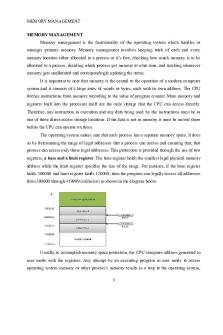Management Consulting Lecture Notes PDF

| Title | Management Consulting Lecture Notes |
|---|---|
| Course | Investment Analysis |
| Institution | University of Technology Sydney |
| Pages | 14 |
| File Size | 1.3 MB |
| File Type | |
| Total Downloads | 418 |
| Total Views | 543 |
Summary
Management Consulting Lecture NotesLecture 1: Understanding Management Consulting as complex problem solvingOverview - What is management consulting - Our approach to problem solving - Thinking as a management consultant: some brain teasers - Introducing UTS ShopfrontWhat do management consultants d...
Description
Management Consulting Lecture Notes Lecture 1: Understanding Management Consulting as complex problem solving
Overview - What is management consulting - Our approach to problem solving - Thinking as a management consultant: some brain teasers - Introducing UTS Shopfront What do management consultants do? - Definition: From Latin consultare to ask advice or to deliberate Implies providing strategic advice based on analysis and evidence - “The creation of value for organisations, through the application of knowledge, techniques and assets, to improve business performance. This is achieved through the rendering of objective advice and/or the implementation of business solution”
Solving Problems: the 4s Method - Why- To Avoid Typical Problem-Solving Pitfalls: Flawed problem definition Solution confirmation Wrong framework Narrow framing Miscommunication 4s stages - State the problem - Structure the problem - Solve the problem - Sell the problem o However, not all management problems are the same; they require different approaches
4S and different problems
Can you think as a consultant?
] Lecture 2- Managing Clients and preparing a proposal Key topics
-
Selling consulting Stating the problem: TOSCA framework Preparing a consulting proposal
What are the characteristics of consulting services? Characteristics of the consulting service 1. Ambiguous Quality Heterogeneous Evaluation Non-standard Issues 2. Immaterial Project Perishable Management Situational Issues 3. Interactive Relation Coproduced Management/Political Relational Issues Quality evaluation issues - It is difficult to isolate the impact of consulting advice on performance - Consulting intervention itself destroys any base case for comparison - Evaluation is largely subjective - Presence of vested interests (e.g. internal sponsors) - Consulting involves an ongoing negotiation of needs, trust and value Multiple contributions of consultants
Challenges for Consulting Services Service Features Knowledge-based
Need Manage knowledge
Intangible/Fuzzy
Signal competence
Co-produced
Learn from clients
Managerial Challenges Continuous learning & knowledge capture Impression and reputation management Client-consultant relationship
Measuring success in a high-relation setting - The question to be asked is not just: was the advice technically sound and well receive by the client? BUT ALSO: - Has our consulting activity produced a positive change in what the client organisation does?
Stating the problem: TOSCA framework
Trouble - What makes the problem (or opportunity) real and present? - Trouble= gap between observation and aspiration Owner - Who is asking for this problem to be solved and who will judge both problem and definition and the solution? - Identify who is the project sponsor - Who are the key decision makers? Success Criteria - What will success look like: ask client to picture ideal future - If possible, translate ‘ideal future’ in quantifiable targets - Make sure it is realistic and be ready to review it - Ignore possible solutions: focus on identifying the problem Constraints - Consider constraints (and trade-offs) affecting success criteria - Prior commitments? - Conflicting objectives? - Resource limitations? - Access limitations?
Actors -
Who are the stakeholders Who have a say on the issue? How influential are they? Who do they want?
Preparing your proposal (assignment 1)
Proposal Template: Title - Short but descriptive - Helps support and define the task Executive summary - 200-300 words max: describe the entire content of the report Client background and requirements - Identify key issues (using TOSCA) Objectives/Scope - SMART objectives - Separately identify in scope/out of scope (MoSCoW)
Proposal Structure
SMART Objectives - Specific What/How/Why/Who/When - Measurable Quantifiable (specify metrics) - Achievable Doable, considering constraints and capabilities - Realistic/Relevant Linked to strategic business goal - Time-bound Clear deadlines Objectives—more specific and measurable than goals/aims. Eg objective; to be N1 in xxx market—quantifiable statement about a desired strategic goal. “ cant you just…”—clients always try to push the boundaries—get the clients to commit to your piece of work. A brief description of what you think you need to do—talk to the board; do research etc. Objectives—clarify the individual roles in delivering the objectives. Outcomes—really important—what the business should be able to do as a result of the consulting advice you give—what are you leaving behind you? What are the deliverables and timeframe—report, presentation, documentation, draft survey or interview questionnaire, process for getting funding etc.
MoSCoW scope - Must
-
Requirement that must be satisfied in the final solution Should High-priority item that should be included in the solution if it is possible Could Requirement which is considered desirable but not Won’t (wouldn’t) Requirement that stakeholders have agreed will not be implemented in a given release, but may be considered for the future
Lecture 3: Structing the problem, deductive and inductive approaches TOSCA
Narrow down the problem
4s Stages: - State - Structure - Solve - Sell Different types of problem solving
Applying deductive approaches: Building a Hypothesis Pyramid
Deductive Reasoning
Building a hypothesis pyramid
MECE - Mutually exclusive, collectively exhaustive - Method of representing complex information in an easy way
MECE Example: ways to increase sales
Hypothesis hierarchy
Example
Applying inducitive approaches: Growing an Issue Tree Indiuctive reasoning
What is the Issue Tree?
What is the Issue Tree: 80/20 rule (Pareto principle) - 80% of the problems come from 20% of the causes - Separates the “vital few” from the “useful many” - Isolates the key issues and tasks that will most likely have the greatest impact when answering a question. How to build an issue tree: example
Issue 1- Increasing costs - From the client’s responses the consultant may formulate 3 possible hypotheses about explanatory factors
-
The 3 preliminary hypothesis are thought provoking & can help the consultant with initial conversation as he/she works towards understanding the situation But what is missing from this preliminary analysis?
What is missing? - Losses can result not only from the ‘cost side’ but also from the revenue side of the equation Profits = Revenues – Costs - The short conversation with the client did not address the whole field of enquiry - It is up to the consultant to ‘enrich’ the conversation… What might that (2nd issue) be? Issue 2- Declining revenues? - Probing questions: 1. Are your company sales growing as fast as the industry? 2. Has your company boosted its advertising spending as fast as industry rivals? New set of hypothesis
An Issue Tree...
Similar Free PDFs

Management Consulting Lecture Notes
- 14 Pages

LECTURE 3 Management lecture notes
- 35 Pages
Popular Institutions
- Tinajero National High School - Annex
- Politeknik Caltex Riau
- Yokohama City University
- SGT University
- University of Al-Qadisiyah
- Divine Word College of Vigan
- Techniek College Rotterdam
- Universidade de Santiago
- Universiti Teknologi MARA Cawangan Johor Kampus Pasir Gudang
- Poltekkes Kemenkes Yogyakarta
- Baguio City National High School
- Colegio san marcos
- preparatoria uno
- Centro de Bachillerato Tecnológico Industrial y de Servicios No. 107
- Dalian Maritime University
- Quang Trung Secondary School
- Colegio Tecnológico en Informática
- Corporación Regional de Educación Superior
- Grupo CEDVA
- Dar Al Uloom University
- Centro de Estudios Preuniversitarios de la Universidad Nacional de Ingeniería
- 上智大学
- Aakash International School, Nuna Majara
- San Felipe Neri Catholic School
- Kang Chiao International School - New Taipei City
- Misamis Occidental National High School
- Institución Educativa Escuela Normal Juan Ladrilleros
- Kolehiyo ng Pantukan
- Batanes State College
- Instituto Continental
- Sekolah Menengah Kejuruan Kesehatan Kaltara (Tarakan)
- Colegio de La Inmaculada Concepcion - Cebu













